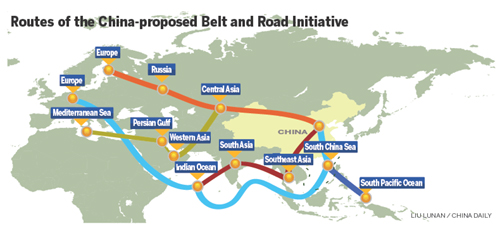'Belt and Road' takes new route
Updated: 2015-04-15 07:24
By CHEN JIA(China Daily)
|
|||||||||||

South Pacific finds its place on official TV demonstration map of trade, investment plan
China's efforts to map new directions for its trade and investment and enhance its global standing got a further boost on Monday after the government included the South Pacific in the latest official route demonstration map of the "Belt and Road Initiative".
The map, released by China's national television CCTV, shows the 21st Century Maritime Silk Road starting from Chinese coastal ports and running through the South China Sea to the Indian Ocean and then Europe. The south line of the Maritime Silk Road extends eastward to the South Pacific.
In conjunction with the land route of the Silk Road Economic Belt, the whole picture is completely consistent with the government's action plan, jointly released by the National Development and Reform Commission, the Ministry of Foreign Affairs and the Ministry of Commerce on March 28.
The on-land belt showed three directions: from China to Central Asia and Russia, then to Europe; via Central Asia and Western Asia to the Persian Gulf and Mediterranean Sea; and via Southeast Asia and South Asia to the Indian Ocean.
Zhang Xiaoqiang, vice-chairman of the China Center for International Economic Exchanges, a government think tank, said that "the Belt and Road will become the world's longest, most potential and most active economic corridors", as they link the economic circles of East Asia, Europe and North America and account for about 75 percent of the global economy.
After unveiling the principles, framework and cooperation priorities and mechanisms of the "Belt and Road Initiative", in a bid to enhance regional connectivity, the government is going ahead with the implementation of the plan, and it said more significant construction projects will be released "step by step".
Ou Xiaoli, an official from the State Council's special working group on the initiative, said on Friday at a seminar that every province, autonomous region and municipality will participate in the blueprint.
"The next step is to make specific plans by local governments guided by the general framework, and the whole progress will be pushed by the cooperation among different regions," said Ou.
The key infrastructure construction projects are the "breakthrough point" of the overall plan. Enterprises, other than the government, will push forward the development, he said.
A primary project list has been approved by the leadership, according to Ou, but it is still confidential. He said the "Belt and Road" summit forum would be the main information platform and dialogue mechanism for leaders from more than 60 countries and regions involved.
"Bilateral and multilateral cooperation in the region is expected to speed up," said Ou.
The "Belt and Road Initiative" was put forward by President Xi Jinping in 2013, with the purpose of rejuvenating the two ancient trading routes and further opening up the markets in a mutually beneficial manner.
The president also highlighted the strategy while addressing the opening ceremony of the 2015 annual conference of the Boao Forum for Asia in the southernmost island province of Hainan.
The China-led Asian Infrastructure Investment Bank will provide financial support to relevant projects, and so far 52 countries and regions have joined or applied to join as founding members of the bank.
Report: Companies must be aware of risks, rewards
Companies from China should be aware of the significant risks and the considerable opportunities as the government implements a strategy to revive the historical trading connections along the ancient Silk Road, said a report from a United Kingdom-based think tank.
Though the Silk Road Economic Belt and the 21st Century Maritime Silk Road offer many opportunities to boost trade, they also bring challenges due to the uncertain political, economic and regulatory conditions in the involved countries and regions despite their strategic importance to China's foreign relations, the Economist Intelligence Unit said in its report.
Citing an example, the report highlighted the political stability risk in Kazakhstan and said popular protests could drive an increasingly nationalist agenda. Similarly, foreign firms may suffer unfair rulings on contractual disputes in the local courts in Vietnam. Labor market risks in Malaysia may increase as the labor shortages are likely to persist, it said.
In addition, security reasons, government effectiveness, tax policies and the standard of local infrastructure may also create barriers for China's plan.
Liu Qian, director of China Forecasting Services at the EIU, said: "While there are opportunities, the strong policy support for the strategy may prove a weakness if Chinese companies fall into a false sense of security about the government's scheme."
The report also assessed credit risks in more than 60 countries and regions likely to fall under the "Belt and Road Initiative", using quantitative and qualitative indicators across different categories, including sovereign, currency and banking sector risks.
Related Stories
Silk Road Initiative takes new route on TV map 2015-04-14 17:12
Voyage revisits the Maritime Silk Road 2015-04-14 16:25
Discoveries offer fresh look at Silk Road history 2015-04-14 07:43
Origin of Maritime Silk Road 2015-04-13 17:58
China Southern Airlines flies high on Silk Road 2015-04-13 14:27
China's construction of Silk Road transport corridor benefits Armenia 2015-04-11 11:35
Today's Top News
Holocaust memories to live on
Problem-plagued Milan Expo battles a long list of headaches
Foreign ministers call for end to fighting in east Ukraine
Spotlight set to shine on royal sibling
Stronger yuan boosts tourism
Exhibition recalls zoo wardens who hid dozens of Jews
Germanwings flight canceled after bomb threat
Failed developer shoots dead 3, injuries 2 in Milan
Hot Topics
Lunar probe , China growth forecasts, Emission rules get tougher, China seen through 'colored lens', International board,
Editor's Picks

|

|

|

|

|

|






